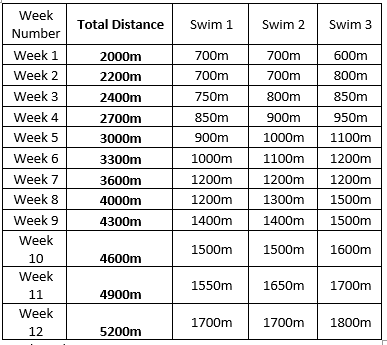
How to plan your Swim Marathon Challenge
WaterAid invites you to dive into their virtual swimming event, Swim Marathon.
From August, complete a full or half marathon challenge over 12 weeks in your local pool or open water swim spot, and raise funds for the 1 in 10 people in the world who don’t have clean water drinking close to home.
A marathon – 26 miles or 42.2km – is a long way to swim, but swimmers are adept at taking big goals (see the September issue of Outdoor Swimmer magazine for more on tackling big challenges) and breaking them down into small, bite-sized chunks. For example, in an English Chanel solo, swimmers say they take it from one feed to the next. In cold water swimming, try thinking about it 10 strokes at a time. To complete the Swim Marathon in 12 weeks, just take it one swim at a time.
There are two main ways you can break a 42.2km swim into manageable swims over several weeks. The first option, which we recommend for people who already swim regularly, is to set a weekly target of the same distance each week and each session and space the distance out evenly (see Table 1). The second option is better if you haven’t been swimming regularly, starting from a small amount at the beginning and building up over time as your fitness improves (see Table 2).
It’s good to have a rest day regularly if you’re swimming and accumulating distance. We therefore suggest a maximum of six swims per week.
Table 1 – Even distance each week and each session (suitable for regular swimmers)

Table 2: Building distance each week (better for new swimmers)

Where to swim
As an outdoor swimming magazine, we love swimming outdoors – in lakes, lidos, rivers, and the sea, but with temperatures starting to drop, a warm swimming pool beckons for swims over a certain time or distance.
Autumn brings with it brilliant light and beautiful colours, but also a change of conditions at outdoor swimming spots which might make swimming long distances difficult as a result of temperature or increased water flow. Our safety advice has some tips for how to assess a swim’s feasibility, and always swim within your capability, swimming with experienced locals if you visit new swim spots.
Outdoor swimming at organised venues can offer more stability of conditions than rivers or the sea. However, going into autumn, the water temperature decreases and the days shorten, venues reduce their opening hours. Some close for winter.
Ultimately, swim where you are comfortable and can work towards the challenge you set yourself.
Outdoor Swimmer’s top tips for making WaterAid’s Swim Marathon fun and achievable
1. Make the swim challenge an adventure
We outdoor swimmers like doing different things – seeing new places, meeting new people. When your swim is an adventure, the distance just seems to disappear.
Here are some options to make the swim challenge an adventure:
- Swim 1km in 42 different places – (maybe do any outdoors swims first before the water temperature drops too much). Or, swim a mile in 26 different places
- Swim 1km every day for 42 days (or 1 mile for 26 days) – in the same spot and diary how it changes.
- Swim with a different person for every swim.
2. Be realistic
The general rule of thumb is that you can increase distance by 10% per week from what you’ve previously been comfortable swimming. Be kind to yourself and don’t try to do too much too soon. Start where you can, and finish where you do.
3. Make a plan, write it down, put it in your calendar
Despite best intentions, it can be easy to miss a session when work, family, friends, and need for sleep stack up. If you are aiming to swim three times a week (for example) decide which days and times you will swim and try to stick to them. Our bodies get into the rhythm of exercise. Also, family and friends can plan around your training schedules.
4. Book the swim sessions as far in advance as you can.
One of the benefits of post-covid swimming is that you can pre-book swim slots at pools, lidos and venues. While it can be frustrating to only be able to swim at that allotted time – it can be motivational, having committed to it and usually paid for it, which can help you to turn up.
5. Tell other people you’re doing it and get sponsored
Obviously, if you want to raise funds, you need to tell people what you’re doing and why. But telling people also helps with your commitment because once you’ve told people about it, they can help keep you accountable. Why not also invite them to swim a session or two with you too and make it a social occasion?








